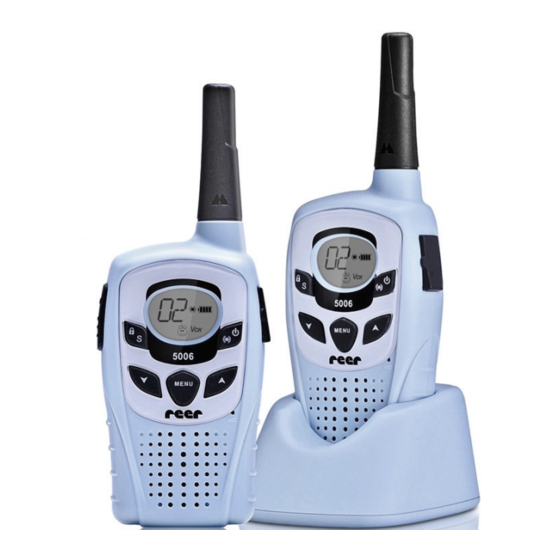
Reer 5006 SCOPI User Manual
Hide thumbs
Also See for 5006 SCOPI:
- Manual (96 pages) ,
- User manual (64 pages) ,
- Quick start manual (8 pages)
Table of Contents
Advertisement
Quick Links
Download this manual
See also:
User Manual
Advertisement
Table of Contents

Summary of Contents for Reer 5006 SCOPI
- Page 1 5006 SCOPI User Manual...
- Page 2 Safety Precautions and other legally binding information. Prepare Radio As Baby Monitor System Your reer 5006 Scopi comes in a two-pack. In default setting both units are equal portable transceivers, working according to the European standard PMR 446 for free use.
- Page 3 Display and Icons Icons and Terms Reception: listen via the speaker Transmission: PTT button is pressed or unit transmits in VOX mode SCAN Auto scan: unit scans channels one by one Active VOX mode: unit transmits automatically (without pressing PTT) when detecting sounds Key tones are activated Out-of-range function is activated (automatically AU, manually Pb, or both)
- Page 4 Chapter 1: Baby Monitor Function Prepare Unit – Insert Battery Remove the belt clip (pull spring and remove to top) and open the battery compartment. Insert a supplied battery pack in each unit (packed separately). The arrow on the battery pack indicates the direction in which to insert: The arrow shows up and the print must be legible after insertion, as shown in the figure).
- Page 5 Prepare As Baby Monitor It only takes one simple programming step after inserting and charging the battery pack to determine which unit will serve as the baby unit and which one as the parent unit. • Turn one unit on (press the On/Off button for 3 sec).
- Page 6 Channel Number The channel number must be the same for both units. There are 9 possible settings, for the baby unit and for the parent unit 1 to 9 stands for channel combinations programmed ex factory between PMR 446 radio channels and CTCSS encoding.
- Page 7 Automatic Out-Of-Range Function The automatic out-of-range function is automatically activated in babysitter mode and needs no further settings! The automatic out-of-range function automatically checks every 60 seconds if baby and parent units are communicating. The parent unit sends a “search pulse”, which is answered by the baby unit.
-
Page 8: External Microphone
External Microphone For the baby monitor function we supply an external microphone (type BM 1). This has the following advantages: • It is more sensitive than the build-in microphone and it responds to a greater distance. • It allows you to extend the distance between transceiver and baby cot – HF radiation is greatly reduced! •... -
Page 9: Select Channel
If both units display the same channel number they are ready for use. Press the PTT button on the left side of the unit to communicate. PTT Button To Talk • Press and hold the PTT button to transmit; release the button to receive. PTT Button To Call •... -
Page 10: Keypad Lock
If communicating with users of other transceiver makes only use channels 1 to 8 and set the sub codes manually, they are following international standards. Set Channel • Press the MENU button once. The currently set channel flashes. • Press to select a different setting. - Page 11 The CTCSS (continuous tone coded squelch signal) tones are inaudible low frequency tones mixed into the microphone signal. On reception the unit checks if the set tone exists and only enables the speaker after detecting the correct tone. For channels 1 to 8 the CTCSS codes can be set manually: •...
-
Page 12: Roger Beep On/Off
RX - Squelch On/Off You can deactivate the automatic squelch and set the unit to continuously receive any signal on the channel. This is helpful at the edge of the range and communication is interrupted or if you just want to listen to what is happening on the channel. The menu item is displayed;... -
Page 13: Weee And Recycling
D- 71229 Leonberg Contact our service hotline by phone 0700-73 33 74 62 4 (12 cents/ minute from German fixed phone network) or e-mail at service@reer.de. Before returning a product check in chapter “Troubleshooting” for some easy steps and tests or contact our hotline: Troubleshooting - Reset Remove the batteries and wait 2 minutes before inserting them again. - Page 14 can cause problems, such as being able to receive but not to transmit. Frequency Table PMR 446 Channel Frequency (MHz) Channel Frequency (MHz) 446.00625 446.05625 446.01875 446.06875 446.03125 446.08125 446.04375 446.09375 CTCSS Code Table Freq. Freq. Freq. Freq. 67.0 97.4 136.5 192.8 71.9...















Need help?
Do you have a question about the 5006 SCOPI and is the answer not in the manual?
Questions and answers